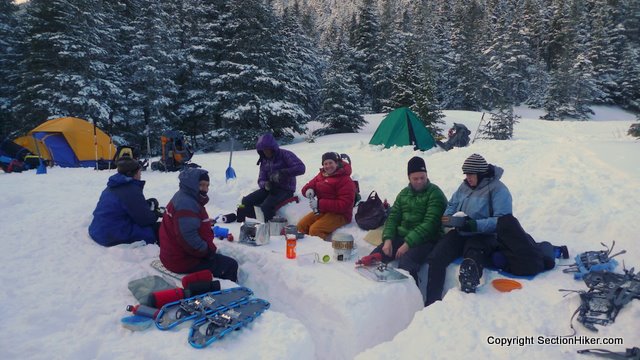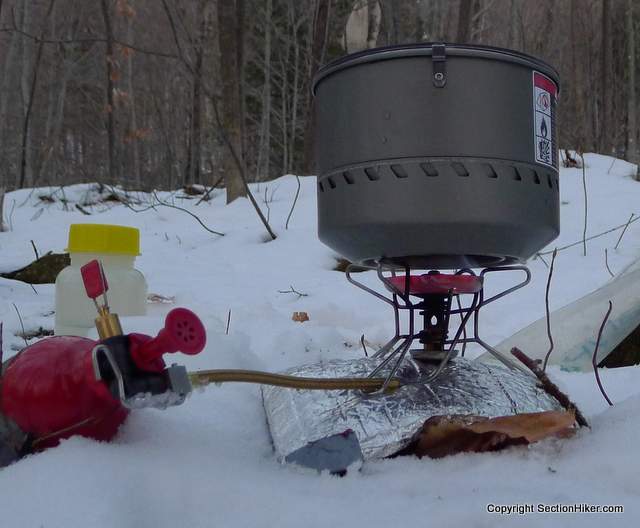Winter backpacking and mountaineering are great sports. But the cost of winter gear is very expensive, upward of $2000 or more. In my experience, it’s best to acquire winter backpacking gear over a period of 2-3 years, so you can spread out the capital expenditure required while using some of your existing three-season gear for camping and backpacking in less extreme winter conditions.
If after a few years you decide you want to undertake a multi-day winter backpacking trip or an expedition mountaineering trip, you’ll be better informed about the type of gear required, how to use it, and how much money it’s going to take to acquire it. While you can always dive in feet first and buy all your gear in one year, it’s better to take things a little slower. Experience can save you a lot of money.
A Phased Approach to Winter Backpacking
In the sections below, I outline a three-year timeline of skill acquisition and corresponding gear purchases. I include expected price ranges for each recommended gear item so you can estimate what your capital outlay will be.
- Year One: Focus on acquiring the insulated footwear and clothing required for winter day hiking. This includes winter traction aids, such as microspikes, snowshoes, and crampons and developing a 4-layer winter clothing layering system that includes a base layer, mid-layer, wind/rain protection, and a very warm outer layer.
- Year Two: Gear up for 1-night winter backpacking trips in temperatures that are 10 degrees or warmer at night. You’ll want to assemble additional gear for setting up a winter campsite including a winter sleeping pad, liquid fuel stove, winter cookware, and insulated pants, while using as much of your three-season gear as possible, such as your tent, backpack and sleeping bag if they’re suitable for moderate winter use (explained further below.)
- Year Three: If after a few winter backpacks, you decide you want to go for longer or colder winter backpacking trips or take it up a notch and go on a mountaineering expedition, this is the time to invest in an expensive cold-weather bag ($800 or more), an expedition-sized backpack, tent, and mountaineering boots. You can also rent a lot of this gear if you go with a guide as a way to keep your gear costs down.

Year One: Footwear, Traction Aids, Insulated Outer Layer, Basic Accessories.
Your focus is to build a solid foundation for winter day hiking, starting with boots, traction aids, and a layered clothing system.
- Depending on where you hike, you may also need real crampons. If this is your first pair, I would suggest buying “universal” strap-on crampons because they are compatible with any kind of boot, including mountaineering boots. Hillsound Trail Crampon Pros are an excellent choice, compatible with hard-sole and soft-sole boots. Price range: $100-200.
- Get yourself a pair of snowshoes with a rear-heel wire called a televator if you need to climb uphill. Check out the MSR Snowshoe Selection Guide which explains what to look for in a snowshoe for different conditions and how to size them. It’s a good read even if you don’t end up buying MSR snowshoes. Price range: $175-380.
- Buy high gaiters to keep your calves warm and protect your lower legs from sharp crampon spikes. OR Crocodiles are what most people use. They are bomber-tough and last forever. Price range: $75-125.
- You need to carry hot water bottles wrapped in insulated covers in winter to prevent them from freezing. Nalgene insulated water bottle carriers (the ones with the zippered top lid) are compatible with 32 oz wide-mouth Nalgene bottles. Price range: $20. Putting a bottle inside a wool sock also works if you keep it inside your pack until you’re ready to drink.
- Winter clothing layers: You probably own a three-season rain jacket, rain pants, long underwear, a mid-layer fleece, hiking socks, and assorted hats and gloves already. You can use all of them for winter hiking. I would recommend investing in a hooded-down parka, however, mainly for use when you’ve stopped for breaks during hikes. You’ll also use this same parka for sitting outside to cook and melt snow for drinking water if you start winter backpacking, so get the warmest and lightest-weight jacket you can afford. The Montbell Mirage Parka and the The North Face HMLYN Parka are good options. Price range: $350-500

Year 2: Winter camping gear and insulated clothing
The next step is to acquire the gear necessary to camp out in winter in temperatures down to 10 degrees Fahrenheit while leveraging your existing three-season gear as much as possible to save money. Check the weather forecast before you go to avoid cold temperatures below your sleeping bag rating.
- You’ll need a warmer sleeping pad for sleeping on snow. I recommend getting a Thermarest XTherm NXT Insulated Sleeping Pad, which is lightweight and packs up small. You can also carry a foam pad like the Thermarest Zlite (which also makes a good insulated camp seat) to augment a 3-season sleeping pad. Your goal should be to have one or two sleeping pads, that when combined, have an R-value of 5 to 7. See Sleeping Bag R-Values for a complete list of sleeping pad R-values for dozens of sleeping pads. Price range: $40-$250.
- If you already own a 20-degree sleeping bag, you should be able to extend its temperature range by 10-15 degrees with a sleeping bag liner, like the Sea-to-Summit Reactor Plus, in order to avoid having to buy a 0-degree or -20 degree sleeping bag. If not, I’d recommend buying a 0-degree sleeping bag, like the Marmot Lithium 0 instead of a -20 or -40 below-zero sleeping bag. There’s a much bigger selection available and prices are far more reasonable. You can also extend the temperature range of a 0-degree bag with an insulated sleeping bag liner if you decide you want to camp in colder temperatures at a future date. Price range: $450-$650.
- If you already own a double-wall three-season tent it can be used for winter camping as long as the fly comes down to the ground to block the wind and you avoid heavy snowfall, which can collapse the tent. Most ultralight trekking pole tents are usually too cold and breezy to use. You’ll want to get snow stakes to pitch the tent on snow, although plastic shopping bags can also be used – just bury them – and secure your guylines to the handles. When you want to buy a tent, I recommend getting a Black Diamond Firstlight 2 or an MSR Access 2 Tent because they’re bomber, lightweight, freestanding, and easy to set up. Price range: $350-800.
- Liquid fuel stoves that burn white gas are recommended for cold weather operation and melting snow to make drinking water when it’s less than 20 degrees Fahrenheit outside. I recommend the MSR Whisperlite Universal Stove because it can be used to burn liquid fuel (white gas) or canister fuel the rest of the year. Price range: $100-200.
- Get a large cook pot, at least 2 liters in size for melting snow in winter. Anodized aluminum pots are much better for snow-melting than titanium because they hold more heat and therefore use less fuel. I recommend getting a Sea-to-Summit 1.9L Alpha Pot.
- When you go camping you’ll want to bring a metal avalanche shovel to dig out snow structures like a kitchen, wind walls, or slit trenches for blocking the wind. Buy one like the Black Diamond Transfer Shovel that is lightweight and that you can take apart for ease of packing. Price range: $50-125.
- One of the biggest challenges faced by winter backpackers is how to prevent your boots from freezing solid at night. While you can buy mountaineering boots with removable liners and sleep with them in your sleeping bag, there’s nothing to stop you from wearing plastic bags or vapor barrier socks inside your boots to prevent them from becoming damps with perspiration. See Vapor Barrier Socks Using Reynolds Oven Bags.

Year 3: Multi-day Winter Backpacks and Expedition Mountaineering
If you decide after year 2 that you want to take multi-day winter backpacking trips into colder, harsher temperatures and terrain, things can get really expensive.
- You need to carry a larger backpack in the 65-85 liter size range in winter, especially if you’re doing longer day trips or overnight camping. See the 10 Best Winter Backpacks for advice about the best models to buy. Price range: $200-600.
- If you plan on hiking multi-day route, I’d advise getting a pair of hiking boots with removable liners that you can sleep with at night in your sleeping bag. Unpleasant as it sounds, this is the best way to keep your boots from freezing at night. See the Winter Hiking Boots FAQ for advice on what to look for in mountaineering boots. Price range: $300-600.
Conclusion
Phasing your gear purchases over a multi-year period is just one strategy for gradually accumulating the gear you need for winter backpacking. As you can see, things really get expensive in Year 3 if you decide you want to backpack in subzero conditions. My advice: take your time in deciding what kind of winter hiking and backpacking you want to do. While backpacking in very cold weather is an adventure, it’s far less comfortable and fun than backpacking in slightly warmer temperatures. Take the time to figure out what you like and let that be your guide in what gear to buy.
SectionHiker is reader-supported. We only make money if you purchase a product through our affiliate links. Help us continue to test and write unsponsored and independent gear reviews, beginner FAQs, and free hiking guides.
